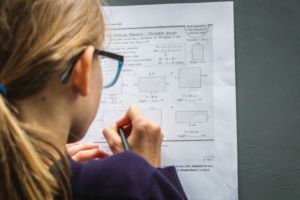
In my Sept., 2022 blog I talked about some of my research around implementing confidence ratings with struggling math students to raise their achievement. At the time of my research in 2005, I knew it was a good strategy, and I had some very positive results to back it up, but my sample size was very small. In the end, Zimmerman’s ideas in Developing Self-Regulated Learners worked for me, but I didn’t know if it would work for other teachers as well. I thought it probably would, but I didn’t know for sure.
As a classroom teacher, I did not have the time or resources to create a full-blown study of the strategy. I used it in my own classroom for a year and then switched schedules to teach advanced exceptional learners in Algebra and Geometry in a middle school setting. I was excited for another year of confidence ratings. I quickly found, however, this strategy rendered useless with this population as they already connected their planning to their outcomes and had high confidence in their math ability. They just didn’t need it, and I abandoned the confidence ratings after just a few cycles.
Fast forward to 2017 and along comes John Hattie and Visible Learning for Mathematics. I’m reading along, and suddenly the text becomes very familiar. In the middle of discussing learning intentions and success criteria and the importance of students knowing where they’re going, he begins describing self-reported grades. I looked at the effect size of 1.33 and think this is fantastic. This has got to be some new idea that’s gonna be a game-changer. As I read on I realized it’s the exact same strategy I was doing with my kids 17 years ago.
Self-reported grades help the teacher understand where the student is with their expectations. This allows the teacher to implement strategies to help the student exceed those expectations and, in turn, gain confidence for future learning. It also increases the student’s self-efficacy by spotlighting the connection between preparation and outcomes, giving the student a clear and often new feeling of “I can do this.”
“It also increases the student’s self-efficacy by spotlighting the connection between preparation and outcomes, giving the student a clear and often new feeling of ‘I can do this.’”

It is done by asking students to predict their outcome for an upcoming assessment, then compare that prediction to the actual outcome and engage the students in a discussion of the two scores. The discussions allow students to reconcile any discrepancies between their expected and actual scores. The teacher can help them implement new learning strategies if needed or bolster current strategies to make them more effective.
It was great then, and it’s still great now.
I recently spoke to a teacher just beginning to implement self-reported grades with his students. After just a couple of rounds of predictions and conversations, he stated that he was already seeing a positive change in his students with respect to their attitude and effort.
The big difference between Hattie and Zimmerman is the depth of the research. Hattie had time to study the studies and research the researchers, the work that I could not have imagined doing. What I find most interesting, and if I’m being honest, exciting, is that self-reported grades topped Hattie’s list of influences with an effect size of 1.33. This is over 3 times the ‘average’ effect size of 0.4 that results in one year’s growth. Done with fidelity, implementing self-reported grades has the ability to accelerate growth over 3.3 times the average.
In this post-pandemic era when teachers are seeing more students than ever before who are behind in a variety of measures for a variety of reasons, this seems to be as close to a silver bullet or magic wand as I have found to accelerate learning.
“In this post-pandemic era when teachers are seeing more students than ever before who are behind in a variety of measures for a variety of reasons, this seems to be as close to a silver bullet or magic wand as I have found to accelerate learning.”
These are resources I used when implementing this idea. Feel free to use as is or use as a springboard to create your own!
Source –
Visible Learning for Mathematics, John Hattie, et. al., Corwin, 2017.

